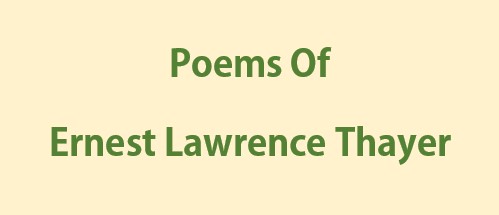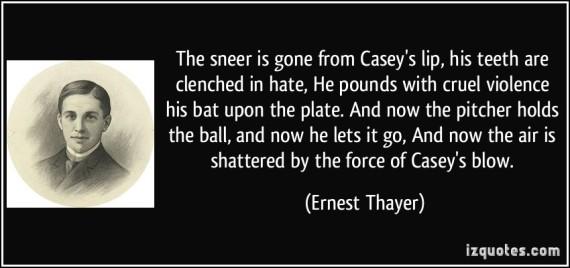

Thayer wrote only a few poems after that, all of which appeared in newspapers and were quickly forgotten. It also created a kind of mini-industry for Hopper, who estimated that he recited the poem more than 10,000 times during his career. The reading was a hit and gained wide popular acceptance. Hopper was performing at Wallack’s Theatre, which was featuring a baseball theme night, with members of the Chicago White Sox and New York Giants in the audience. The poem might have been forgotten except for its reading by renowned actor De Wolf Hopper in New York City during the late 1880s. “Casey at the Bat” was written in May of 1888 and first appeared in the Examiner on June 3rd of that year.


For the next year and a half, until his health failed, Thayer worked for the Examiner, turning out editorials, obituaries, and ballad poems, often under the pen name “Phin,” for five dollars a column. Following his graduation in 1885, Thayer was offered a job by Hearst, who had just taken over the San Francisco Examiner. While a philosophy major at Harvard, Thayer met future newspaper tycoon William Randolph Hearst when the two worked together on the Harvard Lampoon. He was the son of Edward Davis (a manufacturer of woolen goods) and Ellen Darling Thayer. Thayer was born in Lawrence, Massachusetts, on August 14, 1863. Thus, DeWolf Hopper launched his own career and immortalized “Casey at the Bat.” Hopper later wrote that he had recited baseball’s most famous poem more than ten thousand times during the following forty-seven years. Hopper recited the ballad in August of 1888, in between acts of a play he was performing in New York, and the audience gave him a riotous standing ovation.

“Casey at the Bat” gained its fame through a novelist, Archibald Gunter, who gave a newspaper clipping of the ballad to an actor friend named DeWolf Hopper. He was assigned to write editorials and ballads for the newspaper, and “Casey at the Bat” was published in the Examiner on June 3, 1888, under his pseudonym “Phin.” Although Thayer wrote many other ballads besides “Casey at the Bat,” they all passed into obscurity. There are certain works of art that have gained the status as true pieces of Americana, such as Mark Twain’s novel Huckleberry Finn, Thomas Hopper’s painting Nighthawks, Tennessee William’s play A Streetcar Named Desire, and Ernest Thayer’s ballad “Casey at the Bat.” Thayer was a newspaperman for William Randolph Hearst’s San Francisco Daily Examiner during the last part of the nineteenth century and the beginning of the twentieth century.


 0 kommentar(er)
0 kommentar(er)
